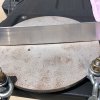I have a very nice AR 500 plate I got from another member. It has only been hit with handgun rounds. Likely 500 hits or more?
I was tearing things down after shooting this morning and noticed the plate has taken-on a dish shape. The curve is TOWARDS the impacts, not away from them.
I layer a straight edge across the plate and it is roughly 1/8” of curve.
May need to turn it around and see if I can shoot it flat again.

I was tearing things down after shooting this morning and noticed the plate has taken-on a dish shape. The curve is TOWARDS the impacts, not away from them.
I layer a straight edge across the plate and it is roughly 1/8” of curve.
May need to turn it around and see if I can shoot it flat again.

